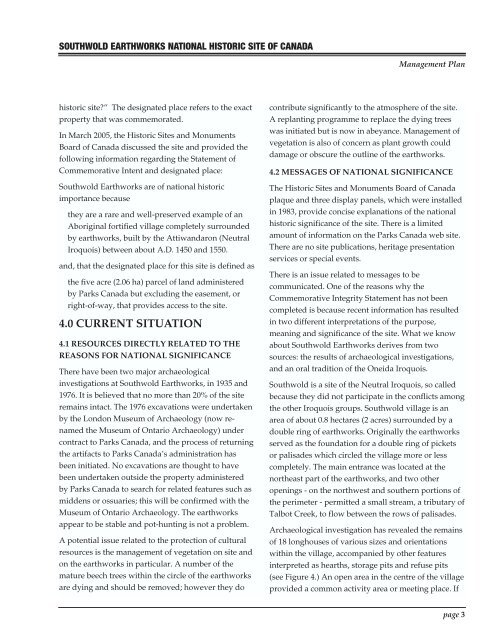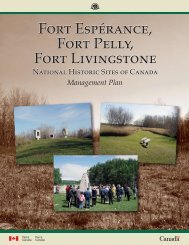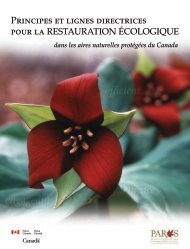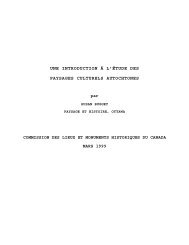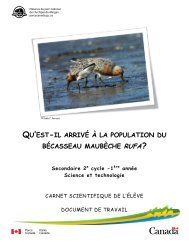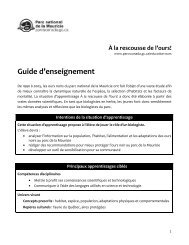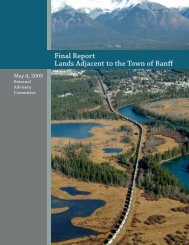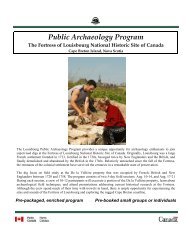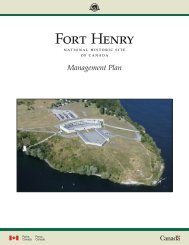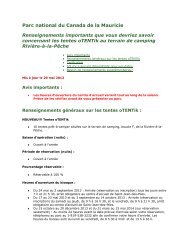Southwold Earthworks National Historic Site of Canada ...
Southwold Earthworks National Historic Site of Canada ...
Southwold Earthworks National Historic Site of Canada ...
You also want an ePaper? Increase the reach of your titles
YUMPU automatically turns print PDFs into web optimized ePapers that Google loves.
SOUTHWOLD EARTHWORKS NATIONAL HISTORIC SITE OF CANADA<br />
Management Plan<br />
historic site?” The designated place refers to the exact<br />
property that was commemorated.<br />
In March 2005, the <strong>Historic</strong> <strong>Site</strong>s and Monuments<br />
Board <strong>of</strong> <strong>Canada</strong> discussed the site and provided the<br />
following information regarding the Statement <strong>of</strong><br />
Commemorative Intent and designated place:<br />
<strong>Southwold</strong> <strong>Earthworks</strong> are <strong>of</strong> national historic<br />
importance because<br />
they are a rare and well-preserved example <strong>of</strong> an<br />
Aboriginal fortified village completely surrounded<br />
by earthworks, built by the Attiwandaron (Neutral<br />
Iroquois) between about A.D. 1450 and 1550.<br />
and, that the designated place for this site is defined as<br />
the five acre (2.06 ha) parcel <strong>of</strong> land administered<br />
by Parks <strong>Canada</strong> but excluding the easement, or<br />
right-<strong>of</strong>-way, that provides access to the site.<br />
4.0 CURRENT SITUATION<br />
4.1 RESOURCES DIRECTLY RELATED TO THE<br />
REASONS FOR NATIONAL SIGNIFICANCE<br />
There have been two major archaeological<br />
investigations at <strong>Southwold</strong> <strong>Earthworks</strong>, in 1935 and<br />
1976. It is believed that no more than 20% <strong>of</strong> the site<br />
remains intact. The 1976 excavations were undertaken<br />
by the London Museum <strong>of</strong> Archaeology (now renamed<br />
the Museum <strong>of</strong> Ontario Archaeology) under<br />
contract to Parks <strong>Canada</strong>, and the process <strong>of</strong> returning<br />
the artifacts to Parks <strong>Canada</strong>’s administration has<br />
been initiated. No excavations are thought to have<br />
been undertaken outside the property administered<br />
by Parks <strong>Canada</strong> to search for related features such as<br />
middens or ossuaries; this will be confirmed with the<br />
Museum <strong>of</strong> Ontario Archaeology. The earthworks<br />
appear to be stable and pot-hunting is not a problem.<br />
A potential issue related to the protection <strong>of</strong> cultural<br />
resources is the management <strong>of</strong> vegetation on site and<br />
on the earthworks in particular. A number <strong>of</strong> the<br />
mature beech trees within the circle <strong>of</strong> the earthworks<br />
are dying and should be removed; however they do<br />
contribute significantly to the atmosphere <strong>of</strong> the site.<br />
A replanting programme to replace the dying trees<br />
was initiated but is now in abeyance. Management <strong>of</strong><br />
vegetation is also <strong>of</strong> concern as plant growth could<br />
damage or obscure the outline <strong>of</strong> the earthworks.<br />
4.2 MESSAGES OF NATIONAL SIGNIFICANCE<br />
The <strong>Historic</strong> <strong>Site</strong>s and Monuments Board <strong>of</strong> <strong>Canada</strong><br />
plaque and three display panels, which were installed<br />
in 1983, provide concise explanations <strong>of</strong> the national<br />
historic significance <strong>of</strong> the site. There is a limited<br />
amount <strong>of</strong> information on the Parks <strong>Canada</strong> web site.<br />
There are no site publications, heritage presentation<br />
services or special events.<br />
There is an issue related to messages to be<br />
communicated. One <strong>of</strong> the reasons why the<br />
Commemorative Integrity Statement has not been<br />
completed is because recent information has resulted<br />
in two different interpretations <strong>of</strong> the purpose,<br />
meaning and significance <strong>of</strong> the site. What we know<br />
about <strong>Southwold</strong> <strong>Earthworks</strong> derives from two<br />
sources: the results <strong>of</strong> archaeological investigations,<br />
and an oral tradition <strong>of</strong> the Oneida Iroquois.<br />
<strong>Southwold</strong> is a site <strong>of</strong> the Neutral Iroquois, so called<br />
because they did not participate in the conflicts among<br />
the other Iroquois groups. <strong>Southwold</strong> village is an<br />
area <strong>of</strong> about 0.8 hectares (2 acres) surrounded by a<br />
double ring <strong>of</strong> earthworks. Originally the earthworks<br />
served as the foundation for a double ring <strong>of</strong> pickets<br />
or palisades which circled the village more or less<br />
completely. The main entrance was located at the<br />
northeast part <strong>of</strong> the earthworks, and two other<br />
openings - on the northwest and southern portions <strong>of</strong><br />
the perimeter - permitted a small stream, a tributary <strong>of</strong><br />
Talbot Creek, to flow between the rows <strong>of</strong> palisades.<br />
Archaeological investigation has revealed the remains<br />
<strong>of</strong> 18 longhouses <strong>of</strong> various sizes and orientations<br />
within the village, accompanied by other features<br />
interpreted as hearths, storage pits and refuse pits<br />
(see Figure 4.) An open area in the centre <strong>of</strong> the village<br />
provided a common activity area or meeting place. If<br />
page 3


